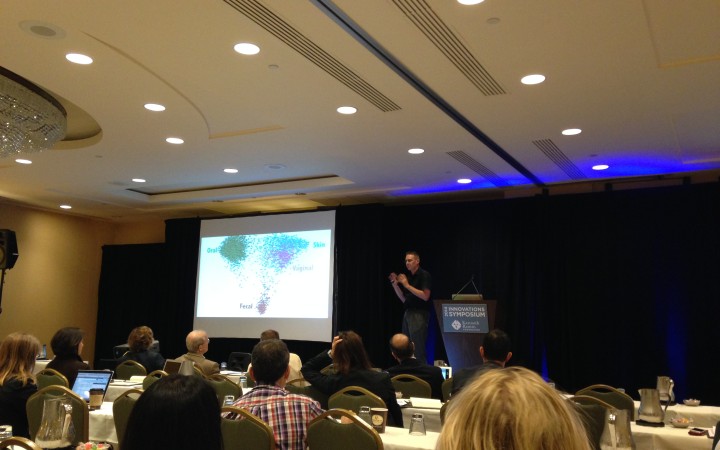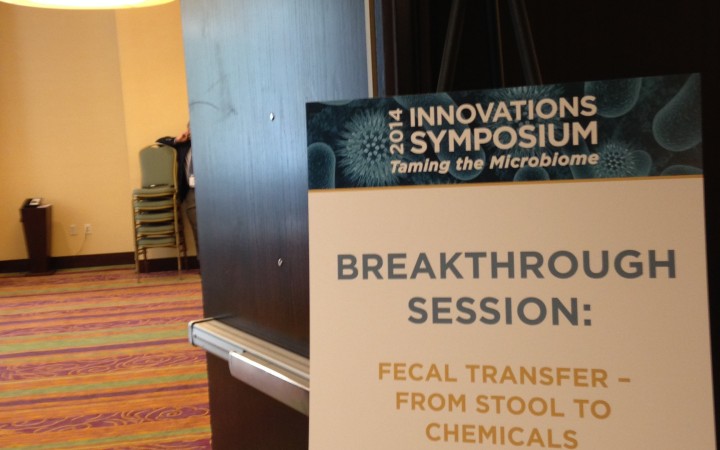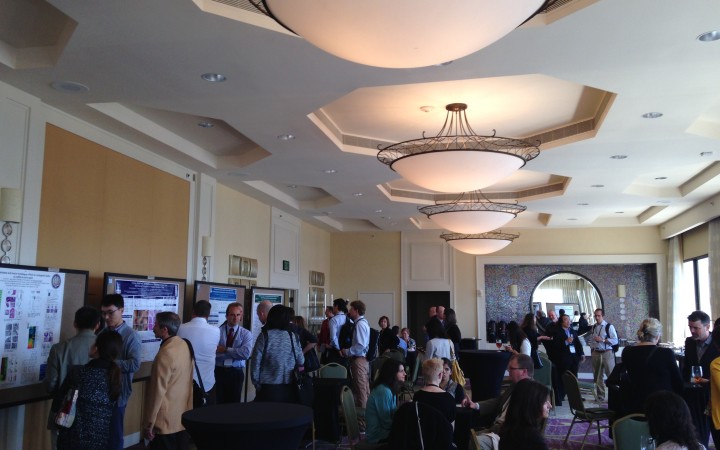
Bioluminescence – the production of light by a living organism.
Fecal transplant – an increasingly-accepted medical treatment involving the transfer of stool from a healthy patient to a sick patient.
[caption id="attachment\\_11739" align="alignright" width="300"][](http://en.wikipedia.org/wiki/Noctiluca\_scintillans#mediaviewer/File:Noctiluca\_scintillans.jpg) Noctiluca scintillans, a species of bioluminescent dinoflagellate, in Belgium. Hans Hillewaert, Creative Commons.[/caption]
These two fascinating, perhaps even eccentric, capabilities of living things recently occupied quite distinct corners of my mind: the corner reserved for “adventures that most people want to hear about” (a night-time kayaking trip in Point Reyes, CA during a dinoflagellate bloom), and the corner reserved for “medical facts to carefully share only in particular social settings” (the poop transfer).
But unrelated fields can collide in jaw-dropping ways, if given the right opportunity. I recently attended a symposium, hosted by the Kenneth Rainin Foundation, entitled “Taming the Microbiome.” The symposium featured specialists spanning microbial genomics to pediatrics who were brought together at the Marriott in downtown San Francisco to “foster innovative and creative thinking about inflammatory bowel disease (IBD).” IBD, which includes a variety of widespread gut diseases such as Crohn’s disease and ulcerative colitis, continues to stump medical practitioners across developed nations, in spite of its well-appreciated association with genetics.
The Rainin Foundation, a charitable organization founded by the same man who developed one of the more popular pipettes used in biology and chemistry, had struck out three years ago to make a dent in the mystery of IBD by hosting an annual “Innovations Symposium,” centered around a disease as opposed to a broader field such as cancer or microbiology.
“When you're looking for innovative ideas and collaborations, you have to provide the space for scientists to come together and learn from each other, and work toward a common cause of ultimately finding a cure,” says Jennifer Rainin, president of the foundation. The focus on IBD “allows us to stay effective,” she explains, “creating connections and opportunities… and breaking down barriers to accelerate IBD research.”
Fecal transplants have been in the news lately, as have the trillions of microbes living inside and around all of us – I’m far from the first person to have blogged about these topics in the past couple years. Dr. Averil Ma, a member of the Rainin Foundation’s Scientific Advisory Board (and a professor at UCSF), summed up the field for me. “For the past centuries going back to Hippocrates, doctors never would’ve thought that the contents of our intestines were something we should be thinking about, it’s something we got rid of,” he says. Recently, however, “it's dawned on biologists and physicians that we've grown up with the bacteria in our intestines. Evolutionarily, in species far more primitive than us, there's always a presence of bacteria in the intestines, and it's become apparent that those bacteria are in fact always talking to each other and talking to us and coexisting as sort of a larger entity.”
Suffice to say, I was pumped to hear from leaders from the field about progress being made in understanding the gut microbiome and just why fecal transplants were so promising. But the symposium kicked off not with an IBD biologist or physician – rather, a biologist who studies bioluminescent squid!
Margaret McFall-Ngai, an esteemed professor of Medical Microbiology and Immunology at University of Wisconsin-Madison, drew my immediate, rapt attention with a call for supporting research in model organisms (hear, hear!) Her model organism of choice, though, isn’t quite as popular as mouse or fly – it’s the Hawaiian bobtail squid. I had never heard of this little critter, but within minutes, my jaw had, in fact dropped.
The bobtail squid engages in one of the most remarkable examples of symbiosis with a microbe, allowing it to camouflage itself while it forages for food at night. During the squid’s early life, a growing ‘light organ’ filters millions of bacterial cells in the ocean water down to just a handful of individual cells from just one species, Vibrio fischeri. These cells then colonize the epithelium, or outermost layered tissue, of the light organ, and by the time the squid is an adult, the light organ is a symbiotic machine.
The squid provides the V. fischeri colony with various nutrients, and manipulates the bacteria so that most bioluminescence occurs at night: 90% of the bacterial colony is pushed back into the ocean each morning, and by evening, the remaing 10% have recolonized the organ and are ready to produce light. The light organ contains lens-like structures that focus the light through the body of the squid to mimic the reflections of the moon and the stars, disguising the squid from predators: it is a “reverse eye” that emits light.
Because the squid can reproduce easily in captivity, and because the bacteria can be grown in petri dishes, scientists have been able to manipulate the biology of the bacteria and then observe, in real-time and at high-resolution, how symbiosis proceeds. McFall-Ngai and her colleagues created a light-deficient strain of the bacteria and discovered that the light organ rejects “cheater” bacteria. No point in feeding a bacterial colony if it doesn’t pay its bill in lumens.
But how does this work? Not only does the light organ resemble a reverse eye, but it also contains opsins (the proteins found in rods and cones in your retina that detect light), and is photosensitive. The light organ both produces light (by harboring V. fischeri), and monitors the light production directly by ‘seeing it.’ Remember, we’re talking about an organ that is found deep with the squid’s body.
McFall-Ngai has been studying the squid for 25 years, and that dedication has paid off: her lab, and the labs of her collaborators and former students, can observe the concurrent development of young squid alongside the growth of the V. fischeri colony. Unlike the human gut, the bobtail squid’s light organ possesses just one type of bacteria, but just like the human gut, there seems to be a back-and-forth between host and symbiont upon which both parties depend. While we can’t directly observe the colonization of the human gut by bacteria at all stages of life, the “squid-vibrio” system allows for controlled experiments that tease apart the fine details of squid light-organ symbiosis. McFall-Ngai’s work spans biophysics to ecology, and handily demonstrates one of her mantras: “We’ve forgotten that we are embedded in our environment.” No human is ‘germ-free.’ Our biology depends on the biology of germs.
[caption id="attachment\\_11738" align="alignright" width="300"][](http://berkeleysciencereview.com/wp-content/uploads/2014/07/photo-2.jpg) Rob Knight wows the symposium audience with easy-to-understand data on the types of microbes found in your mouth (top left), skin (top right), and gut/stool (bottom). (Levi Gadye)[/caption]
Though many of the other speakers and poster presenters at the symposium described groundbreaking work on IBD spanning mouse models, to drug delivery, to fecal transplants, McFall-Ngai’s story about the bobtail squid stuck with me. The inclusion of her work at a symposium on IBD speaks volumes about what is required to understand a complex disease. I heard great talks about the microbiome itself, particularly from Michael Fischbach (a young professor who harnesses vast public databases to identify potent antibiotics being produced by gut bacteria) and Rob Knight (who has used modern techniques in bioinformatics to illustrate how our gut diversity changes over time, or in response to drugs). But I also heard talks about the underappreciated role of viruses in the gut (Ian Lipkin, a ‘virus hunter,’ entitled his talk “Small Game Hunting"), as well as parasites like hookworms that are sometimes beneficial for sick patients. The Rainin Foundation’s goal of spurring innovative interactions was working: Jennifer Rainin had told me that the symposium was described as ‘brain candy’ by attendees in the past. I could see why. To understand how bacteria interact with our gut, we need to understand how bacteria/animal interactions work in general.
In addition to all the great talks though, I needed a particular update to satisfy my curiosity. What was the state of research on fecal transplants? I had no choice: I found myself sitting in a circle of doctors, scientists, startup entrepreneurs, and non-profit workers at a ‘breakthrough session’ entitled “Fecal Transfer: from stool to chemicals.” I learned a few surprising things.
[caption id="attachment\\_11737" align="alignleft" width="300"][](http://berkeleysciencereview.com/wp-content/uploads/2014/07/photo-6-e1406580412227.jpg) The breakthrough session I attended, featuring many of the top doctors, scientists, and entrepreneurs who are working to make fecal transfer an accessible, viable, and regulated treatment for patients with IBD. (Levi Gadye)[/caption]
It turns out that fecal transplants don’t result in the recipient patient ‘keeping’ all the donated stool bacteria in their gut. Rather, the stool transplant somehow resets the balance of microbes in patients with C. difficile infections, and perhaps in patients with IBD. Many of the doctors wanted the treatment to be renamed a ‘fecal transfer,’ as it does not constitute a permanent transplant of an organ.
Many of the doctors reported that their IBD patients had excellent results with fecal transfers – between 25% and 70% remission after a series of transfers (very promising compared to the myriad of drug-dependent treatments that are currently available). However, all the doctors felt limited by the FDA, and the subsequently slow pace of clinical research on fecal transfers. In spite of widespread media attention, some predicting a future boutique market for healthy stool, these professionals worried about their inability to advance fecal transfers from a rarely-used, rarely-approved treatment to a marketable and regulated treatment, perhaps consisting of just a few bacteria, or just a few bacterial products, in a pill. Many patients have resorted to DIY fecal transfers – but these are unregulated, and in spite of the apparent safety of the technique, it’s not always advisable that anyone try this at home. Where’s the field going? Somewhere, that much is certain. The field has a full tank of gas, but the destination remains unknown.
I came out of the symposium rejuvinated both in my own research and in my desire to communicate science. Many of the established professors continued to emphasize the need for better funding, better public communication, and better professional interaction relating to the microbiome, IBD, and human health in general.
McFall-Ngai had some home-run comments as the symposium came to a close. She described how peanut butter was a staple food for kids when she went to summer camp decades ago, whereas today, kids line up in the morning to take their meds - and peanut butter is a no-go, given how many kids have allergies to peanuts. (Allergies in general have been on the rise in the past century). With regard to the spike of IBD in developed countries since WWII, she says “You can’t have these [rapid] changes at the genetic level. We need to use epigenetics and environment to explain how we got here.” Given the poster I saw showing how recent immigrants to the US develop IBD in the first few decades of their assimilation into the American lifestyle, these words rang true. Why does a small but consistent percentage of Americans suffer from IBD, while nearly 300 million of us engage in this lifestyle?
[caption id="attachment\\_11741" align="alignleft" width="300"][](http://berkeleysciencereview.com/wp-content/uploads/2014/07/photo-3.jpg) Poster session at the Innovations Symposium. Posters ranged from clinical studies on fecal transfers to biochemical techniques for tracking bacterial populations in living animals (hopefully, someday, humans!). (Levi Gadye)[/caption]
If the bobtail squid’s reverse eye can pick and choose just five bacterial cells out of trillions in the ocean water, allowing the squid to survive, it doesn’t seem unreasonable to assume that our gut is somehow ‘seeing’ and ‘hosting’ the many bacteria of the gut microbiome, to ensure proper digestion and overall health. Perhaps the guts of Crohn’s patients are unable to converse properly with the right microbes – perhaps the ‘cheaters’ are allowed to stay. Many puzzle pieces still need to be fit in to the biological concept linking the squid-vibrio system with IBD, but thanks to symposiums like this one, I'm hopeful that science and medicine will have a fruitful future of collaboration.



